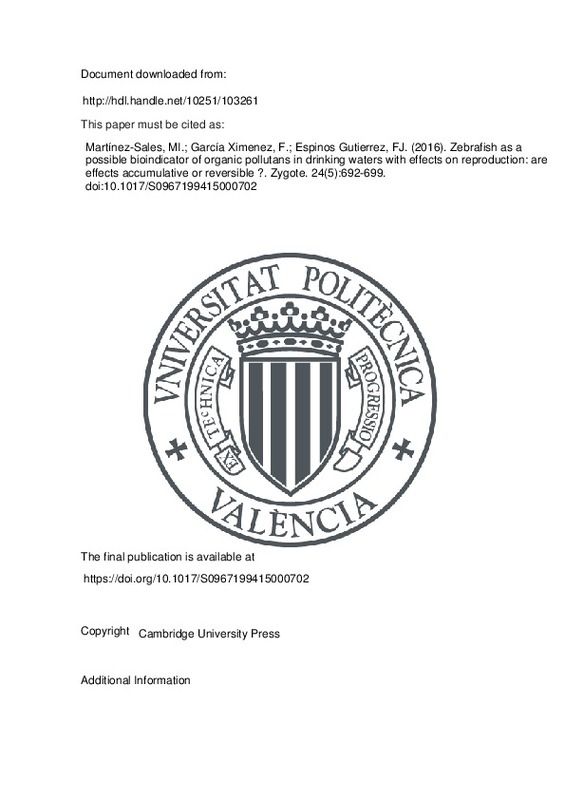JavaScript is disabled for your browser. Some features of this site may not work without it.
Buscar en RiuNet
Listar
Mi cuenta
Estadísticas
Ayuda RiuNet
Admin. UPV
Zebrafish as a possible bioindicator of organic pollutans in drinking waters with effects on reproduction: are effects accumulative or reversible ?
Mostrar el registro sencillo del ítem
Ficheros en el ítem
| dc.contributor.author | Martínez-Sales, María Isabel
|
es_ES |
| dc.contributor.author | García Ximenez, Fernando
|
es_ES |
| dc.contributor.author | Espinos Gutierrez, Francisco Juan
|
es_ES |
| dc.date.accessioned | 2018-06-03T04:25:17Z | |
| dc.date.available | 2018-06-03T04:25:17Z | |
| dc.date.issued | 2016 | es_ES |
| dc.identifier.issn | 0967-1994 | es_ES |
| dc.identifier.uri | http://hdl.handle.net/10251/103261 | |
| dc.description.abstract | [EN] Due to inefficient detection and removal treatments, organic pollutants are present in drinking waters. For this reason, zebrafish is proposed as a complementary control measure in conventional potabilization treatments. According to the most sensitive parameters (hatching rate, fertility rate and underdeveloped specimens) detected in our previous work, in the current work we attempt to study, in these parameters, the possible cumulative effect of environmental pollutants likely present in drinking waters, between generations, when specimens are cultured in the same water in both generations and/or the possible reversibility of these effects when cultured in control water. To this end, batches of 20 embryos with the chorion intact were cultured in 3 drinking waters from different sources (A, B and C) and in one control water up to 5 months, in 20 l tanks. Four replicates were performed in all water groups, with a total of 28 aquariums. Results in water C revealed a non-reversible effect on fertility rate, and also in water C an alteration of sex ratio towards females, although in this case the alteration was reversible. A transgenerational alteration in the germline via epigenetic mechanism from the previous generation is proposed as the most plausible explanation to this effect. | es_ES |
| dc.language | Inglés | es_ES |
| dc.publisher | Cambridge University Press | es_ES |
| dc.relation.ispartof | Zygote | es_ES |
| dc.rights | Reserva de todos los derechos | es_ES |
| dc.subject | Organic pollutants | es_ES |
| dc.subject | Bioindicator | es_ES |
| dc.subject | Epigenetic | es_ES |
| dc.subject | Drinking water | es_ES |
| dc.subject | Zebrafish | es_ES |
| dc.subject.classification | BIOLOGIA ANIMAL | es_ES |
| dc.subject.classification | PRODUCCION ANIMAL | es_ES |
| dc.title | Zebrafish as a possible bioindicator of organic pollutans in drinking waters with effects on reproduction: are effects accumulative or reversible ? | es_ES |
| dc.type | Artículo | es_ES |
| dc.identifier.doi | 10.1017/S0967199415000702 | es_ES |
| dc.rights.accessRights | Abierto | es_ES |
| dc.contributor.affiliation | Universitat Politècnica de València. Departamento de Ciencia Animal - Departament de Ciència Animal | es_ES |
| dc.description.bibliographicCitation | Martínez-Sales, MI.; García Ximenez, F.; Espinos Gutierrez, FJ. (2016). Zebrafish as a possible bioindicator of organic pollutans in drinking waters with effects on reproduction: are effects accumulative or reversible ?. Zygote. 24(5):692-699. doi:10.1017/S0967199415000702 | es_ES |
| dc.description.accrualMethod | S | es_ES |
| dc.relation.publisherversion | https://doi.org/10.1017/S0967199415000702 | es_ES |
| dc.description.upvformatpinicio | 692 | es_ES |
| dc.description.upvformatpfin | 699 | es_ES |
| dc.type.version | info:eu-repo/semantics/publishedVersion | es_ES |
| dc.description.volume | 24 | es_ES |
| dc.description.issue | 5 | es_ES |
| dc.relation.pasarela | S\303285 | es_ES |







![[Cerrado]](/themes/UPV/images/candado.png)

